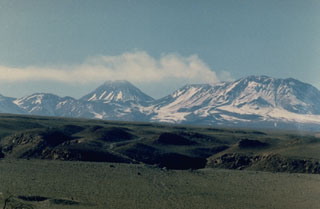Report on Lascar (Chile) — 18 January-24 January 2023
Smithsonian Institution / US Geological Survey
Weekly Volcanic Activity Report, 18 January-24 January 2023
Managing Editor: Sally Sennert.
Please cite this report as:
Global Volcanism Program, 2023. Report on Lascar (Chile) (Sennert, S, ed.). Weekly Volcanic Activity Report, 18 January-24 January 2023. Smithsonian Institution and US Geological Survey.
Lascar
Chile
23.37°S, 67.73°W; summit elev. 5592 m
All times are local (unless otherwise noted)
SERNAGEOMIN reported that after the 19 December 2022 eruption at Láscar, activity levels had returned to baseline. During 1-15 January sulfur dioxide emissions detected by a Differential Absorption Optical Spectroscopy (DOAS) instrument located 6 km ESE of the crater measured an average value of around 483 tonnes per day, with a maximum value of 881 tonnes per day on 13 January. These values were at normal levels. Occasional low-level thermal anomalies were identified in satellite images and corresponded to passive degassing from the vents in the summit crater. The maximum height of white gas plumes was 1.4 km above the crater rim, recorded on 11 January. On 19 January the Alert Level was lowered to Green (the lowest level on a four-color scale) and the public were warned to stay at least 700 m away from the crater. ONEMI reported that a “Preventive Early Warning” was declared for San Pedro de Atacama (70 km NW).
Geological Summary. Láscar is the most active volcano of the northern Chilean Andes. The andesitic-to-dacitic stratovolcano contains six overlapping summit craters. Prominent lava flows descend its NW flanks. An older, higher stratovolcano 5 km E, Volcán Aguas Calientes, displays a well-developed summit crater and a probable Holocene lava flow near its summit (de Silva and Francis, 1991). Láscar consists of two major edifices; activity began at the eastern volcano and then shifted to the western cone. The largest eruption took place about 26,500 years ago, and following the eruption of the Tumbres scoria flow about 9000 years ago, activity shifted back to the eastern edifice, where three overlapping craters were formed. Frequent small-to-moderate explosive eruptions have been recorded since the mid-19th century, along with periodic larger eruptions that produced ashfall hundreds of kilometers away. The largest historical eruption took place in 1993, producing pyroclastic flows to 8.5 km NW of the summit and ashfall in Buenos Aires.
Sources: Servicio Nacional de Geología y Minería (SERNAGEOMIN), Oficina Nacional de Emergencia-Ministerio del Interior (ONEMI)

